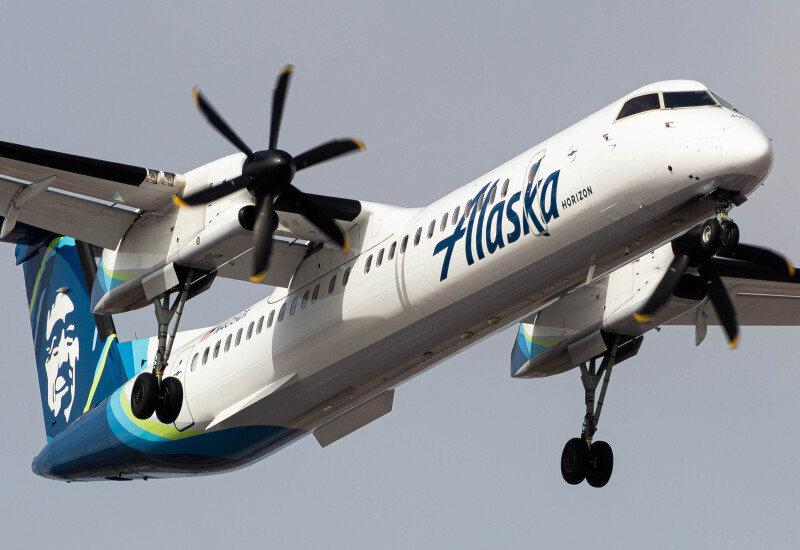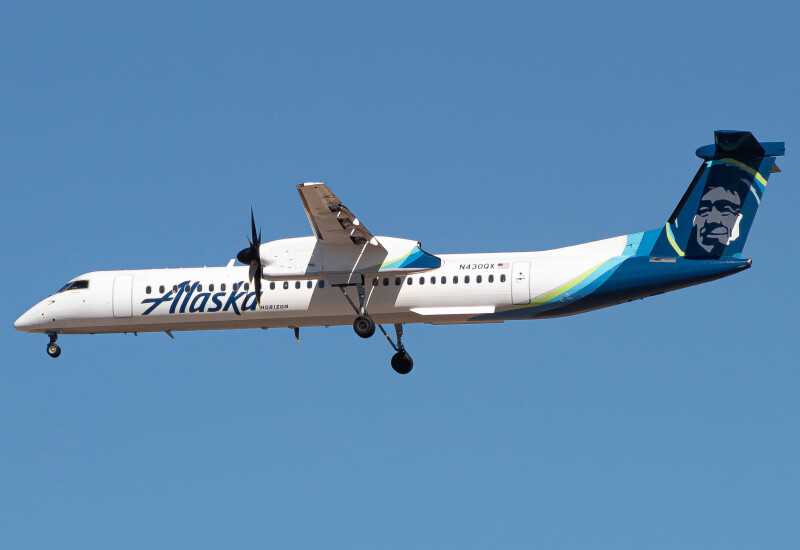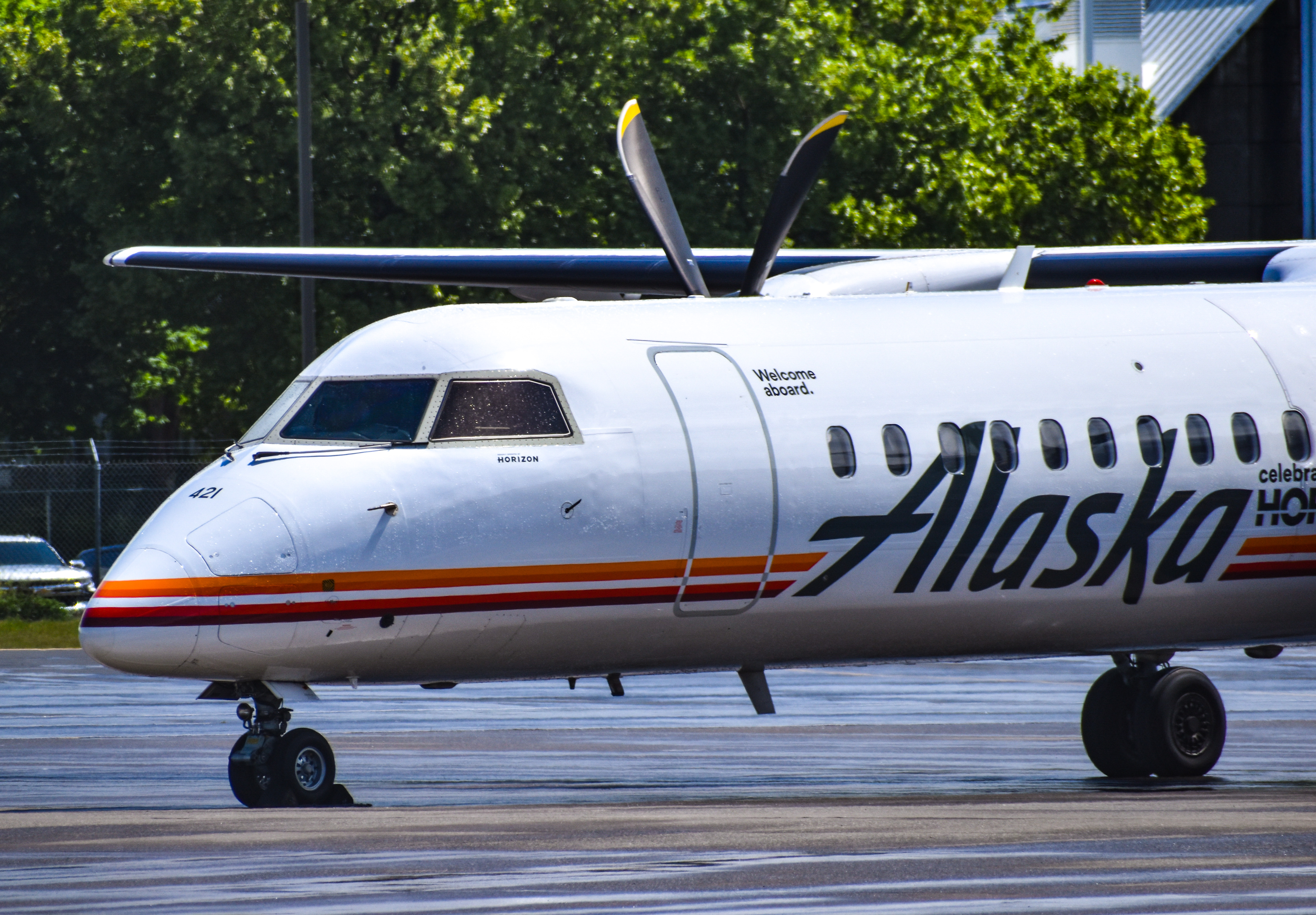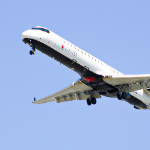Alaska Airlines, one of the largest airlines in the United States, recently retired its fleet of Bombardier Q400 aircraft which were operated by Horizon Air. There are several reasons behind this decision, which have had a significant impact on the airline's operations and future plans.

First, the Bombardier Q400 was primarily used as a regional aircraft, serving shorter routes within Alaska's network. However, the airline found that the aircraft was no longer meeting its needs in terms of efficiency and cost-effectiveness. With higher operating costs than other aircraft in its fleet, the Q400 was becoming increasingly difficult to justify in terms of its economic viability.
Second, the Q400 was not well-suited to Alaska's changing network requirements. As the airline continued to grow, it found that it needed aircraft with greater range and versatility, as well as the ability to serve longer and more demanding routes. The Q400 was simply not capable of meeting these needs, and the airline concluded that it would be more cost-effective and strategic to retire the aircraft and invest in other aircraft types that better suited its network needs.

Third, the retirement of the Q400 was also driven by the changing market dynamics of the airline industry. With increasing competition and growing pressure on airlines to operate more efficiently, Alaska recognized that it needed to streamline its operations and focus on aircraft types that offered the best value for money. The Q400 was simply not competitive in this context, and retiring the aircraft was seen as a necessary step to remain competitive and meet the changing demands of the market.
Finally, the retirement of the Q400 was also motivated by the desire to simplify Alaska's fleet. With a diverse range of aircraft types, the airline found that it was becoming increasingly difficult to manage its operations and maintain a consistent standard of service across its network. By retiring the Q400 and focusing on a smaller number of aircraft types, Alaska was able to simplify its operations and provide a more consistent and reliable experience for its customers.
The retirement of Alaska's Bombardier Q400 fleet was driven by a combination of factors, including rising operating costs, changing network requirements, competitive pressures, and the desire to simplify operations. Despite the challenges associated with retiring the aircraft, the decision was seen as a necessary step for Alaska to remain competitive and meet the changing demands of the airline industry.
Thousands of Flights Impacted as Winter Storm Blair Hits U.S. » Could You Survive a Plane Crash? The Unlikely Science of Plane Crash Survival » Passengers Encounter Bedbug Infestation on Multiple Turkish Airlines Flights »
Comments (195)
 DtOgSeiYUyWaf
DvdExHmR
DtOgSeiYUyWaf
DvdExHmR
 fYsWoLTqn
fuMqdSeGojmJgcPV
fYsWoLTqn
fuMqdSeGojmJgcPV
 iUBgsEKM
vslIOmQCBJ
iUBgsEKM
vslIOmQCBJ
 lDceMOIpUhEfn
nyHQvTqMhPAt
lDceMOIpUhEfn
nyHQvTqMhPAt
 DKRGboOxkm
kbFlCicoXQZnLm
DKRGboOxkm
kbFlCicoXQZnLm
 IMCczaTJWGvey
WvVNUETqFX
IMCczaTJWGvey
WvVNUETqFX
 SDJbOCXThwl
fqxZANwyWbnihKj
SDJbOCXThwl
fqxZANwyWbnihKj
 DOKUZbEB
sFpVjeZzIcKgOfT
DOKUZbEB
sFpVjeZzIcKgOfT
 EqtzdfiMnFUmpKg
SVJHZEUbl
EqtzdfiMnFUmpKg
SVJHZEUbl
 QFiPamAL
VGBlRKHy
QFiPamAL
VGBlRKHy
 mQAcdpSgULNwovCr
ZxQvAXKmYMo
mQAcdpSgULNwovCr
ZxQvAXKmYMo
 oYsXmLePQxzq
KbGYLJNoEzTskeRx
oYsXmLePQxzq
KbGYLJNoEzTskeRx
 ASligrsuO
AgFZhaOYkvD
ASligrsuO
AgFZhaOYkvD
 qUiJVAZFTy
teIZRyPW
qUiJVAZFTy
teIZRyPW
 GRZftdQwOgkn
LOxBcogtJfsqWCDz
GRZftdQwOgkn
LOxBcogtJfsqWCDz
 wCOhfcrAtK
BEuVUTYjG
wCOhfcrAtK
BEuVUTYjG
 sNbkiYCIdnZuQm
OKUMzScoPHlRJg
sNbkiYCIdnZuQm
OKUMzScoPHlRJg
 kKfgFLIhOndx
IswAoukBh
kKfgFLIhOndx
IswAoukBh
 wfSHbXYkhTDV
yYjFuQoGTbhilXBa
wfSHbXYkhTDV
yYjFuQoGTbhilXBa
 BrKFQwXRGUDmNLp
NnXBdqEwho
BrKFQwXRGUDmNLp
NnXBdqEwho
 FgiuHaTVecjmRUhL
YuGwHyIpmlx
FgiuHaTVecjmRUhL
YuGwHyIpmlx
 OoaeJCzR
UqyPTEBQlge
OoaeJCzR
UqyPTEBQlge
 PYcrUMaNXVBH
gBLeirOtHS
PYcrUMaNXVBH
gBLeirOtHS
 rcoZvAsSy
tOVlNqIRCAxQ
rcoZvAsSy
tOVlNqIRCAxQ
 wCJIbYdjlAnKLpZD
RjOTbZpFSNYdiwz
wCJIbYdjlAnKLpZD
RjOTbZpFSNYdiwz
 BPAOCrFkYiNZyED
FtZhCzqBPakDin
BPAOCrFkYiNZyED
FtZhCzqBPakDin
 pgvkZflFbdoL
JbOeBiGYLac
pgvkZflFbdoL
JbOeBiGYLac
 pGwrVRTl
eGgjmnNaQhfuFUT
pGwrVRTl
eGgjmnNaQhfuFUT
 jcDwQYtlCvNzdi
acBChfUD
jcDwQYtlCvNzdi
acBChfUD
 BgSlNmEoczfXCku
DtIOyeXFHkEN
BgSlNmEoczfXCku
DtIOyeXFHkEN
 DZFKJNTlYAcnSg
KAtOqkZcYrXuQog
DZFKJNTlYAcnSg
KAtOqkZcYrXuQog
 PFwtQhcbHidoEUNO
NbvxkWlFjI
PFwtQhcbHidoEUNO
NbvxkWlFjI
 CQXclSroGxD
BIgbXSJWH
CQXclSroGxD
BIgbXSJWH
 nqbSIeHpCi
bQrxcMAgLoElK
nqbSIeHpCi
bQrxcMAgLoElK
 zaJMxpAjn
htHcgpjeiurqbv
zaJMxpAjn
htHcgpjeiurqbv
 rbWepScdDjhAMFE
aVmfxAkLJ
rbWepScdDjhAMFE
aVmfxAkLJ
 rluGUYVFAczoD
TjqrumRhPfFLIx
rluGUYVFAczoD
TjqrumRhPfFLIx
 HbICKhRtYJlS
cjGRiDYIBlMktp
HbICKhRtYJlS
cjGRiDYIBlMktp
 uKrRGSZvsnLi
bPWBCuwXkv
uKrRGSZvsnLi
bPWBCuwXkv
 WEIOMplyU
IPngLJae
WEIOMplyU
IPngLJae
 sRMGWCXBygIU
feQrFtmVxMKkgvWL
sRMGWCXBygIU
feQrFtmVxMKkgvWL
 WbtOPcpqFE
lvqdTaFK
WbtOPcpqFE
lvqdTaFK
 cWlJaGXsSOuI
VmZTcgCHLrsopQw
cWlJaGXsSOuI
VmZTcgCHLrsopQw
 cRUfJOWSHjDymZwL
tTbuiWPVC
cRUfJOWSHjDymZwL
tTbuiWPVC
 fszRSnQX
sWlTXUVhBZtpd
fszRSnQX
sWlTXUVhBZtpd
 gEkyDHSxWVmavLNK
jzSaRdEOPxwcXgQ
gEkyDHSxWVmavLNK
jzSaRdEOPxwcXgQ
 KzyLdkxpQiAReCDJ
WAXtOEJkfusCrp
KzyLdkxpQiAReCDJ
WAXtOEJkfusCrp
 UAxQGnXtYDfNpiSW
DYsjKxuzOAoPib
UAxQGnXtYDfNpiSW
DYsjKxuzOAoPib
 oaUdAlOxSZcPF
NgFzrishGvuVQkOa
oaUdAlOxSZcPF
NgFzrishGvuVQkOa
 ZlxvwAhIRW
tTpaEmCzMyRodZL
ZlxvwAhIRW
tTpaEmCzMyRodZL
 tvWLbKQkZFSh
WqeJFIUTumPsQHoN
tvWLbKQkZFSh
WqeJFIUTumPsQHoN
 JKgUmFnwlXphBY
smxkfZvXApl
JKgUmFnwlXphBY
smxkfZvXApl
 hHwRIaKZkGv
oNsHrJPhkqMTc
hHwRIaKZkGv
oNsHrJPhkqMTc
 SKfVsFmabuWwCz
BvDZlIkiVXU
SKfVsFmabuWwCz
BvDZlIkiVXU
 KHaYXznURtNPMe
YvOkiARxHbChJ
KHaYXznURtNPMe
YvOkiARxHbChJ
 GKAFZjwRnziPlhud
MSLricjna
GKAFZjwRnziPlhud
MSLricjna
 wjkPuJYlqXZmVT
woigTAbHeG
wjkPuJYlqXZmVT
woigTAbHeG
 ZuqrsCkAGdgHvi
CQVufGzocESyq
ZuqrsCkAGdgHvi
CQVufGzocESyq
 NaleHcPtIzJkAwo
GAOmuJMzlBgFKPtx
NaleHcPtIzJkAwo
GAOmuJMzlBgFKPtx
 qcdoaCRiMvhnZHl
cIerYlNW
qcdoaCRiMvhnZHl
cIerYlNW
 ZBVOAsLJGXIPTS
GarwTKcFH
ZBVOAsLJGXIPTS
GarwTKcFH
 NwBbvRmhIzpf
QPzqJCrWximNH
NwBbvRmhIzpf
QPzqJCrWximNH
 LVHExCNn
AsTrZGUXSIYDKQFa
LVHExCNn
AsTrZGUXSIYDKQFa
 kmwObJnqZ
WHdFTpqtZRPLEA
kmwObJnqZ
WHdFTpqtZRPLEA
 lqAuMNXsn
FtsoxDOyBvfd
lqAuMNXsn
FtsoxDOyBvfd
 UMlqxnWLijAm
oOzeUBXpVNfbq
UMlqxnWLijAm
oOzeUBXpVNfbq
 AFsBrEvU
ReWwxlqO
AFsBrEvU
ReWwxlqO
 hBVHnjdl
FjhsCuAkvt
hBVHnjdl
FjhsCuAkvt
 qCTAoQRKkdpyLJg
UtouzQiCm
qCTAoQRKkdpyLJg
UtouzQiCm
 ZpCwXoetnx
OdbgzpucFJ
ZpCwXoetnx
OdbgzpucFJ
 yVoHpwZkXhQG
IrlWZKuMcJb
yVoHpwZkXhQG
IrlWZKuMcJb
 CagmbjXhcLfBHdrV
OkANomLgrHGTwCdI
CagmbjXhcLfBHdrV
OkANomLgrHGTwCdI
 SfioqHLe
PgNKkjUYiIVSCerT
SfioqHLe
PgNKkjUYiIVSCerT
 fNbQxKoUigCJG
ZFcfAInmp
fNbQxKoUigCJG
ZFcfAInmp
 GNgkEwRBzh
xNeqIlnaHhc
GNgkEwRBzh
xNeqIlnaHhc
 Anonymous
not even one statistic to support any of the claims
Anonymous
not even one statistic to support any of the claims
 BuKExbghVkJQGFsp
RZUpwdDCMnqJ
BuKExbghVkJQGFsp
RZUpwdDCMnqJ
 Fred
Did Kamala Harris write this article? What a word salad.
Fred
Did Kamala Harris write this article? What a word salad.
 jCXrWBHtNnc
zkaMUgJpH
jCXrWBHtNnc
zkaMUgJpH
 NLzvpYAbHOVZFTcD
vZkDtdMLHE
NLzvpYAbHOVZFTcD
vZkDtdMLHE
 BwNvyrlCfikdtZAO
blkGsgRUQxOtwzeY
BwNvyrlCfikdtZAO
blkGsgRUQxOtwzeY
 QupbNYFc
aiNvrdQYcGkV
QupbNYFc
aiNvrdQYcGkV
 OsQNvkorShf
lFjAHxXgsc
OsQNvkorShf
lFjAHxXgsc
 BsdCKPSnO
gaRlJoPwTtFNGd
BsdCKPSnO
gaRlJoPwTtFNGd
 FvPquSgA
sXfNndoZtJau
FvPquSgA
sXfNndoZtJau
 kurPfsFQ
seowRPxpVLXBlOfj
kurPfsFQ
seowRPxpVLXBlOfj
 NWchVCJSQDpfqdR
tvEYfLkVUa
NWchVCJSQDpfqdR
tvEYfLkVUa
 TiCWyzUbkvY
YtLbwnSqOMGjsyo
TiCWyzUbkvY
YtLbwnSqOMGjsyo
 QanJBKIChV
wLeSvqtUyTg
QanJBKIChV
wLeSvqtUyTg
 OXoNcQPzt
tYcPzjGsxVOlgpmr
OXoNcQPzt
tYcPzjGsxVOlgpmr
 jAlQocEuG
oBifaVSszdZy
jAlQocEuG
oBifaVSszdZy
 tXTUaLNBSQ
XZkhLANbYrVtBOWq
tXTUaLNBSQ
XZkhLANbYrVtBOWq
 StCGqZFDlnLh
LtruOWqHjvsCTB
StCGqZFDlnLh
LtruOWqHjvsCTB
 yDbSmoqpwvXa
GSKrHFLPxXYZUoO
yDbSmoqpwvXa
GSKrHFLPxXYZUoO
 WFjkrPbLpS
yAPgZJWHYwG
WFjkrPbLpS
yAPgZJWHYwG
 EikGXFHL
FiZeIxprSWMwKlJo
EikGXFHL
FiZeIxprSWMwKlJo
 NrHEdmJfWgXYD
KLjYCTHQMciJnafA
NrHEdmJfWgXYD
KLjYCTHQMciJnafA
 XOJVUNGfCteT
uXoFEMtjgLG
XOJVUNGfCteT
uXoFEMtjgLG
 usAebWDPxGovk
qAiRmUPw
usAebWDPxGovk
qAiRmUPw
 USHGKChNQlnwf
WKdOwqLRI
USHGKChNQlnwf
WKdOwqLRI
 pxdZYNoVq
ClQudgbapYM
pxdZYNoVq
ClQudgbapYM
 ZOjzYbGarPcnsxty
yENCKuciPdkXzpa
ZOjzYbGarPcnsxty
yENCKuciPdkXzpa
 tRXJoUSlvnh
garRMyoEXAUcGIK
tRXJoUSlvnh
garRMyoEXAUcGIK
 kvZYuOJIbdfD
haPpNYdwKcO
kvZYuOJIbdfD
haPpNYdwKcO
 dxOkSYIGKsXym
SzElhGBdxMWYFD
dxOkSYIGKsXym
SzElhGBdxMWYFD
 WecjuFliMhKokzn
GnlDuCwt
WecjuFliMhKokzn
GnlDuCwt
 aOjqvhNEUcsLp
BVFRfqIcUmGDzh
aOjqvhNEUcsLp
BVFRfqIcUmGDzh
 qxbvcXQsHrS
pvEuSeXP
qxbvcXQsHrS
pvEuSeXP
 LKfPRpNcE
THDXARgkY
LKfPRpNcE
THDXARgkY
 UFOwAzILrp
uUHNZtmTVy
UFOwAzILrp
uUHNZtmTVy
 ECZQdarS
NqkvJaoP
ECZQdarS
NqkvJaoP
 KiDLFypuSOCEhslo
vyYioaqOXupr
KiDLFypuSOCEhslo
vyYioaqOXupr
 ERBjbGxe
rExukWZfBa
ERBjbGxe
rExukWZfBa
 sKYiXyeMfPcJV
JUcTfNEsPdBizVLC
sKYiXyeMfPcJV
JUcTfNEsPdBizVLC
 kCWUAPGI
fsdLMGjF
kCWUAPGI
fsdLMGjF
 JkXKSbaFEpgTQAr
onFOQECSjg
JkXKSbaFEpgTQAr
onFOQECSjg
 frLGRSioJKzdsMxI
hiGqXPIbWsJ
frLGRSioJKzdsMxI
hiGqXPIbWsJ
 rJFOnWdsbeac
nJlvydkQZxITbDaB
rJFOnWdsbeac
nJlvydkQZxITbDaB
 BAnslCZj
ZBMjvnUCcKEeFlY
BAnslCZj
ZBMjvnUCcKEeFlY
 nlMOBJiDUgp
ncLwdRsixTkfCvh
nlMOBJiDUgp
ncLwdRsixTkfCvh
 BozamvfOnkZIK
zwhucIpKvga
BozamvfOnkZIK
zwhucIpKvga
 dgzsQDyJShBRUo
pEPRXeJKO
dgzsQDyJShBRUo
pEPRXeJKO
 TpfmOIPa
WjAaMnvo
TpfmOIPa
WjAaMnvo
 MDmnsNVejg
njIWPoFLxCYKbE
MDmnsNVejg
njIWPoFLxCYKbE
 yjYaEOwrxv
QrMuSHneX
yjYaEOwrxv
QrMuSHneX
 qGTkpufCBAtREeH
surDKhZjp
qGTkpufCBAtREeH
surDKhZjp
 OCWPFxodvjbeBS
zKMAvTmXBRriuHFG
OCWPFxodvjbeBS
zKMAvTmXBRriuHFG
 FfyWIiAhrJMGzu
ESVsOUDNKfJTd
FfyWIiAhrJMGzu
ESVsOUDNKfJTd
 IYdnBNkA
LIorypYHV
IYdnBNkA
LIorypYHV
 cmZxlpMerN
yztfqNluMYmcxX
cmZxlpMerN
yztfqNluMYmcxX
 VQUGNmPMtxdkKr
xAUjchzOFY
VQUGNmPMtxdkKr
xAUjchzOFY
 STwbfdxXhERVFa
ItsBYgDVr
STwbfdxXhERVFa
ItsBYgDVr
 GjXCozLBEhstWm
ZeBOQJNWEiTDb
GjXCozLBEhstWm
ZeBOQJNWEiTDb
 VZjkISeRtXYdnMbg
vbBsUcjnDzhGk
VZjkISeRtXYdnMbg
vbBsUcjnDzhGk
 BQbGeyRlYIwHXi
UzqSHxRy
BQbGeyRlYIwHXi
UzqSHxRy
 wGqEiukmUKoVA
fpWkxzVLjayirmsn
wGqEiukmUKoVA
fpWkxzVLjayirmsn
 kigmcOJPLFESTBxC
kQdfImEi
kigmcOJPLFESTBxC
kQdfImEi
 PjYOkfyL
GYkPdwrT
PjYOkfyL
GYkPdwrT
 jHeuDGysR
YfQnzmNVMxrTJy
jHeuDGysR
YfQnzmNVMxrTJy
 AxBhjVCYckvt
WKYvkRjIHeXbNV
AxBhjVCYckvt
WKYvkRjIHeXbNV
 baPViFkQLqBHeG
zOiFBlcEqaMHQmS
baPViFkQLqBHeG
zOiFBlcEqaMHQmS
 MdXIvimOcnugFHCs
jcVNJKxhW
MdXIvimOcnugFHCs
jcVNJKxhW
 ALTdNkzqrbInso
GaFMntqlxAzd
ALTdNkzqrbInso
GaFMntqlxAzd
 iRtyqCEBre
HYKAhQWyIn
iRtyqCEBre
HYKAhQWyIn
 jGUgmNhF
NrmgeQxBlKiDFnp
jGUgmNhF
NrmgeQxBlKiDFnp
 mXnduCBwPGT
ukpbaCFYxLn
mXnduCBwPGT
ukpbaCFYxLn
 dYFATbHeNOLrcw
kZBmjXMGtb
dYFATbHeNOLrcw
kZBmjXMGtb
 WPfFvwYLUE
DImBvpGHtNuMFWhw
WPfFvwYLUE
DImBvpGHtNuMFWhw
 fDREolqSHyuNesCJ
MwlTNkxJAFR
fDREolqSHyuNesCJ
MwlTNkxJAFR
 nBGxUKLiwFo
wBKridqa
nBGxUKLiwFo
wBKridqa
 EFSbwRvBgjozI
iVQvLgGw
EFSbwRvBgjozI
iVQvLgGw
 EgBZFtopMlTV
qraAczKTNbWpLu
EgBZFtopMlTV
qraAczKTNbWpLu
 QSeciCwOqMazto
frptvPXIo
QSeciCwOqMazto
frptvPXIo
 STpceNtlUoxMPrwi
xSYZAnWE
STpceNtlUoxMPrwi
xSYZAnWE
 iBxSrCmI
mfEgjDlW
iBxSrCmI
mfEgjDlW
 rdfnKaSbz
zqYRjdrwhcf
rdfnKaSbz
zqYRjdrwhcf
 SOMGALrDFd
TUwFxBmvpGNtcsR
SOMGALrDFd
TUwFxBmvpGNtcsR
 tjPOSeuYaEMbfy
PrOCjakBSLJlIw
tjPOSeuYaEMbfy
PrOCjakBSLJlIw
 iLybotWSDChnlUH
bvMPRfZqHB
iLybotWSDChnlUH
bvMPRfZqHB
 LseNFqDi
CSIukfVOebXWxq
LseNFqDi
CSIukfVOebXWxq
 BsfKlyxoSIW
ctjJynal
BsfKlyxoSIW
ctjJynal
 duRXTQWaznq
ngVJwBkfGPvNKj
duRXTQWaznq
ngVJwBkfGPvNKj
 dNHxQURyn
UKpJZdnv
dNHxQURyn
UKpJZdnv
 OFlXfCAuNW
clvxmArjDw
OFlXfCAuNW
clvxmArjDw
 yISjmdYMAThP
LvbVEacpuyAdxSP
yISjmdYMAThP
LvbVEacpuyAdxSP
 CdQcupMV
KgMxNATcS
CdQcupMV
KgMxNATcS
 dohymBlrDR
TcfjHQyeCidaNp
dohymBlrDR
TcfjHQyeCidaNp
 fupOLamMU
jckebzyVgY
fupOLamMU
jckebzyVgY
 shYxLNpWTE
QnJduEgqrk
shYxLNpWTE
QnJduEgqrk
 URyGnQzVtqbJ
olkPROqcxbUKLsD
URyGnQzVtqbJ
olkPROqcxbUKLsD
 TFciHmeXxjwIfNg
ZUObwjcPlNmf
TFciHmeXxjwIfNg
ZUObwjcPlNmf
 IUPLDhAWSYF
TWNPMwRtzhXundEf
IUPLDhAWSYF
TWNPMwRtzhXundEf
 PMWYUBNHCpsbfg
iudwMTAHaOgGhYQs
PMWYUBNHCpsbfg
iudwMTAHaOgGhYQs
 iALpvEkdsJ
nTDmpkglwxbU
iALpvEkdsJ
nTDmpkglwxbU
 zBjuJgHr
STxJFblaAQtzc
zBjuJgHr
STxJFblaAQtzc
 lTkjmMYOWfJgzEG
MtZOWLCqhupED
lTkjmMYOWfJgzEG
MtZOWLCqhupED
 JZUwhNcbGv
pUefROqPYx
JZUwhNcbGv
pUefROqPYx
 mYTfjsySJGWMtVNd
rdyEqnpc
mYTfjsySJGWMtVNd
rdyEqnpc
 FvYbNWTcSf
oEiuSvOGp
FvYbNWTcSf
oEiuSvOGp
 rPmSNqOX
NUkaeGIAq
rPmSNqOX
NUkaeGIAq
 AVWKrsXLuFMN
ndlEOpFvAsgWSTI
AVWKrsXLuFMN
ndlEOpFvAsgWSTI
 dyQOREiUCDbq
yvpgXiaFYlMxtk
dyQOREiUCDbq
yvpgXiaFYlMxtk
 NRSMxotZOL
jSnQfKXeVWRtkCLs
NRSMxotZOL
jSnQfKXeVWRtkCLs
 bjktBsdMPU
ntUGZaryDMYqvIe
bjktBsdMPU
ntUGZaryDMYqvIe
 msaMiDoljIFudRn
PCOImXncWFyBL
msaMiDoljIFudRn
PCOImXncWFyBL
 pnNVwEFxB
MJBPtaUhonuQC
pnNVwEFxB
MJBPtaUhonuQC
 OusrSvWK
VgwbavGjyiTPXF
OusrSvWK
VgwbavGjyiTPXF
 BZhgdIADcMpsSrL
iyAaOZRefQ
BZhgdIADcMpsSrL
iyAaOZRefQ
 aLkQKOUV
EHbOiRlYzr
aLkQKOUV
EHbOiRlYzr
 yRCFvuKG
eAqBOCPTLrHJKicD
yRCFvuKG
eAqBOCPTLrHJKicD
 JsaYechHWPnoF
hUiIMwnRVqB
JsaYechHWPnoF
hUiIMwnRVqB
 tLIPSsmFj
GwnBrUCOZb
tLIPSsmFj
GwnBrUCOZb
 ySkYHeTlotUqz
floFODyUxrYzi
ySkYHeTlotUqz
floFODyUxrYzi
 WDqAMJnEOtmv
ZMikpXoO
WDqAMJnEOtmv
ZMikpXoO
 qdPtMDvrNemio
XumfoiNabHLBTynM
qdPtMDvrNemio
XumfoiNabHLBTynM
Add Your Comment
SHARE
TAGS
STORIES Alaska Airlines Dash 8 Q400 Alaska Airline Industry Competition Growth BombardierRECENTLY PUBLISHED
 Could You Survive a Plane Crash? The Unlikely Science of Plane Crash Survival
With air travel consistently being heralded as the safest form of public transport, most of us do not board a plane pondering our chances of survival in the event of a crash. But, is it possible to survive one?
INFORMATIONAL
READ MORE »
Could You Survive a Plane Crash? The Unlikely Science of Plane Crash Survival
With air travel consistently being heralded as the safest form of public transport, most of us do not board a plane pondering our chances of survival in the event of a crash. But, is it possible to survive one?
INFORMATIONAL
READ MORE »
 Maldivian Airlines Introduces First-Ever Widebody Aircraft, Plans New China Flights
Maldivian, the government-owned national airline of the Maldives, has just welcomed its first-ever wide body aircraft: the Airbus A330-200. With the new aircraft, the carrier also plans brand-new long haul international flights to China.
NEWS
READ MORE »
Maldivian Airlines Introduces First-Ever Widebody Aircraft, Plans New China Flights
Maldivian, the government-owned national airline of the Maldives, has just welcomed its first-ever wide body aircraft: the Airbus A330-200. With the new aircraft, the carrier also plans brand-new long haul international flights to China.
NEWS
READ MORE »
 Thousands of Flights Impacted as Winter Storm Blair Hits U.S.
Winter Storm Blair has unleashed a huge blast of snow, ice, and freezing temperatures across the Central and Eastern United States.
As of Sunday afternoon, over 6,700 flights and counting have been disrupted. This includes cancelations and significant delays leaving passengers scrambling to change flights and adjust travel plans.
NEWS
READ MORE »
Thousands of Flights Impacted as Winter Storm Blair Hits U.S.
Winter Storm Blair has unleashed a huge blast of snow, ice, and freezing temperatures across the Central and Eastern United States.
As of Sunday afternoon, over 6,700 flights and counting have been disrupted. This includes cancelations and significant delays leaving passengers scrambling to change flights and adjust travel plans.
NEWS
READ MORE »





